
KINGDOM EUMYCOTA - The True Fungi
Phylum Ascomycota - "The Ascomycetes" - REFER TO CHAPTER 5 IN THE TEXTBOOK.
Many but not all asexually-reproducing fungi (ANAMORPHS - without evidence of sexual reproduction) are likely derived from or associated with the Phylum Ascomycota. Due to their uncertain taxonomic placement, these are place in the Form-Phylum Deuteromycota - "The Deuteromycetes" or "Imperfect Fungi" - REFER TO CHAPTER 7 IN THE TEXTBOOK.
In addition to your textbook, check out:
- http://www.mycolog.com/CHAP4a.htm
- http://www.mycolog.com/CHAP4b.htm
- http://www.mycolog.com/chapter6.htm
- http://www.mycolog.com/chapter7.htm
Members of the Phyla Ascomycota and Deuteromycota produce many plant diseases (e.g., powdery mildews, anthracnose, wilts, rots, leaf spots, ergo of rye, apple scab, chestnut blight, etc.) and some animal and human mycoses (e.g., candidiasis, ringworm infections, histoplasmosis, aspergillosis, toxic black mold syndrome, etc.). Most species and groups are symbiotic, commensalistic, or saprobic.
- Ascomycetes and Deuteromycetes produce septate hyphae.
- Deuteromycetes (produce no sexual stage, only asexual structures - e.g.,
conidia, chlamydospores, arthrospores, sterile mycelium - no spores at all).
- Conidia may be formed in a number of different ways (conidiogenesis) and possess many morphologies.
- Coelomycetes are anamorphic fungi in which the conidia are produced within a protective structure, an acervular or pycnidal conidioma. A conidioma is a multihyphal structure producing conidia.
- Hyphomycetes are conidial anamorphs producing exposed conidiophores, not enclosed in any protective structure.
- Ascomycetes (produce a sexual stage [i.e., bags of spores - ascus with ascospores] + [asexual spores - sometimes?].
- The Holomorph (whole fungus) = Anamorph (asexual reproduction) + Teleomorph (sexual reproduction).
- Sexual Reproduction defines whether a fungus belongs to the phylum Ascomycota or not.
- An ascus (pl. asci) usually contain 4, 8 or multiples of 4 or 8 sexual spores. These can be associated with no other fungal tissue (i.e., naked asci) or with other fungal tissue to form a fruit body, also called an ascocarp or ascoma (i.e., cleistothecium, perithecium, or apothecium).
- Asci may be (1) unitunicate-Operculate, unitunicate-inoperculate, prototuncate, and bitunicate
- The following animation is found at http://www.mycolog.com/CHAP4a.htm
The development of an ascus and the discharge of the ascospores
LINKS: CHECK THESE OUT!
| Morel Life Cycle: An Ascomycete |
- Classification -based largely on morphology, anatomy, and life history.
- For yeasts, physiological characters are especially important (ability to ferment specific sugars) is useful in delimiting species.
- Sexual reproduction results in the formation of a sac called an ascus (plural - asci) which contains 4, 8, or multiples of 4 or 8 spores. The spores are called ascospores.
- Asci may be naked (not surrounded by fungal tissue or an ascoma (an ascocarp having a spore-bearing layer of cells or a hymenium)
-
Definitions - ascocarp - mature fruiting body of an ascomycetous fungus
-
ascoma - an ascocarp having the spore-bearing layer of cells (the hymenium) on a broad disklike receptacle
-
apothecium - a cuplike ascocarp in many lichens and ascomycetous fungi
-
cleistocarp, cleistothecium - closed spore-bearing structure of some fungi (especially Aspergillaceae and Erysiphaceae) from which spores are released only by decay or disintegration
-
perithecium - flask-shaped ascocarp
-
ascomycete, ascomycetous fungus - any fungus of the class Ascomycetes (or subdivision Ascomycota) in which the spores are formed inside an ascus
-
fruiting body - an organ specialized for producing spores
- Seven major classes in the Phylum Ascomycota. Classes 3-7 are referred
to as filamentous ascomycetes.
- Archiascomycetes (Taphrina, Schizosaccharomyces, Pneumocystis)
- Hemiascomycetes Order Saccharomycetales - "the yeasts"
- Plectomycetes (Order Eurotiales and related fungi- e.g., perfect stages Neosartoria and Eurotium for anamorphic species of Aspergillus and Eupenicillium and Talaromyces for anamorphic species of Penicillium)
- Pyrenomycetes (Sordaria, Neurospora, Xylaria, Claviceps, Cordyceps, powdery mildew fungi - Erysiphe, Microsphaera, Uncinula, Phylactinia)
- Discomycetes (Peziza, Morchella, Urnula, Sclerotinia, Monilinia)
- Laboulbeniomycetes (commensals on the exoskeletons of arthropods)
- Loculoascomycetes (Peidraia; perfect stages of Alternaria and Bipolaris)
Class Archiascomycetes (Taphrina, Schizosaccharomyces,
Pneumocystis)
- members of this group are saprobic and parasitic
- members of the group lack ascogenous hyphae and ascocarps
- chitin present in cell walls of some species
- Plant parasites (e.g., Taphrina deformans, the cause of peach
leaf curl). Reproduce through ascospores or conidia and give rise to
yeast-like colonies. Presence of fungus causes rapid cell division and cell
enlargement and resulting in distortion of leaves.
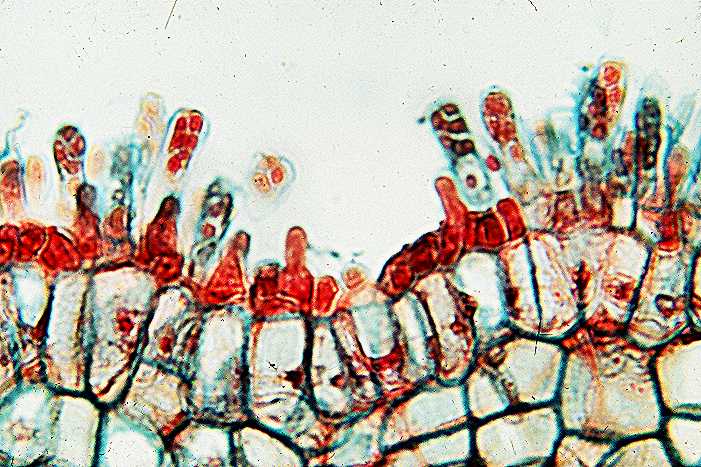
- Schizosaccharomyces - the "split yeast", cytokinesis distributes the cytoplasm equally between two cells.
- Pneumocystis carinii - associated with a virulent form of pneumonia in immunocompromised humans. Originally thought to be a protistan.
- unicellular or very limited mycelium -no ascocarp or ascogenous hyphae usually 4-8 ascospores develop
- Meiosis and ascosporogenesis.
- asci are thin walled and may release their ascospores by deliquescing or eventually breaking
- asexual reproduction through mitosis and unequal cytokinesis ==> budding
-as buds break off, scars are left behind on the somatic or mother cell -
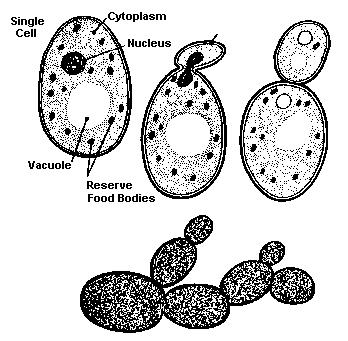
- common on sugary plant exudates (e.g., slime fluxes in tree wounds and the nectar of flowers).
- Saccharomyces cerevisiae and other species are useful in baking, brewing, distilling, and related industries including fuel ethanol production and supplements to food (riboflavin and citric acid).
- Candida albicans and other Candida species can cause candidiasis or yeast infections of mucocutaneous tissue ==> thrush, vaginitis. Common malady in immunocompromised or debilitated individuals, after exposure to antibiotics, or a consequence of pregnancy.
Class Plectomycetes
- simplest members of ascocarp-producing ascomycetes
- asci typically thin-walled, globose to pyriform, evanescent (ephemeral)
- asci scattered at various levels within the ascocarp, not forming a hymenium, arising from ascogenous hyphae of various lengths ramifying through the ascocarp
- ascospores unicellular -ascocarp typically a cleistothecium (no regular opening) when one is present -cleistothecial peridium present and varying in form
- various types of anamorphs and conidial forms -opens by (a) exposure to weather and (b) internal pressure
- saprobes to parasites -examples of fungi in this group include perfect
stages Neosartoria and Eurotium for anamorphic species of
Aspergillus and Eupenicillium and Talaromyces for
anamorphic species of Penicillium.
- Aspergillus flavus = > mycotoxin, aflatoxin (potentially cancer-causing in humans, and deadly to poultry =>turkey X-disease)
- Aspergillus flavus, A. niger, and A. fumigatus may cause Aspergillosis (lung infection and/or allergic reaction in the lung) and fungus balls in lungs and other body parts.
- Aspergillus niger can be used for commercial production of enzymes (e.g., amylase) and various metabolites (e.g., citric acid).
- Penicillium roquefortii is used in the production of blue cheese - cow's milk and Roquefort cheese - ewe's milk. P. camembertii or P. caseiolum are used in the production of Camembert, Brie, and other cheeses.
- Penicillium chrysogenum, common source of antibiotic penicillin; P. griseofulvum yields the antibiotic griseofulvin, used to fight skin-related fungal infections.
- Check out this link on Aspergillus and Penicillium
- dermatophytes or certain pathogenic ringworm fungi or keratinophilic
fungi, such as species of Microsporum and Trichophyton.
Ringworm or dermatophytosis = tinea infections.
- dermatophytes based on their habit t==> geophilic (soil-loving), zoophilic (animal-loving) and anthropophilic (man-loving) species.
- trends in evolution of some species moving from saprobic to parasitic existence.
- Blastomycosis (restricted to eastern part of North America) =
Ajellomyces dermatitidis (anamorph Blastomyces dermatitidis),
Histoplasmosis (conidia common in guano-enriched soil) => Ajellomyces
capsulatus (anamorph Histoplasma capsulatum), Coccidioidomycosis
=> Coccidioides immitis (arthrospores common in soils in the Sonoran
life zone) all cause lung diseases resembling tuberculosis, may become
disseminated and systemic and be potentially fatal.
- Dimorphic fungi (converted from mycelial form to yeast phase) => in culture, by elevating temperature from room temperature to 37oC or in host, within tissues of the human body.
- largest fungal class, more than 6000 representatives are known. - (Sordaria, Neurospora, Xylaria, Claviceps, Cordyceps, powdery mildew fungi (Erysiphe, Microsphaera, Uncinula, Phylactinia)
- ascocarp usually a perithecium or, occasionally, cleistothecial ascocarps.
- unitunicate asci (one layered)
- asci may or may not be forcibly discharged their salvo of spores
- Powdery Mildew Fungi - members of the Order Erysiphales ==> OBLIGATE
PARASITES (not culturable) and these cause diseases collectively referred to
as powdery mildews ==> upper side of leaves look as though it has been
dusted with flour. -Conidia borne in chains on a conidiophore. -Fungus
produces haustoria in epidermis of leaves, penetrates no further. "Powdery
mildews" are only skin deep! Haustorium anchors the fungus to the leaf
surface and absorbs food.
- Conidia are generally colorless, powdery appearance due to presence
of mycelium near end of summer.
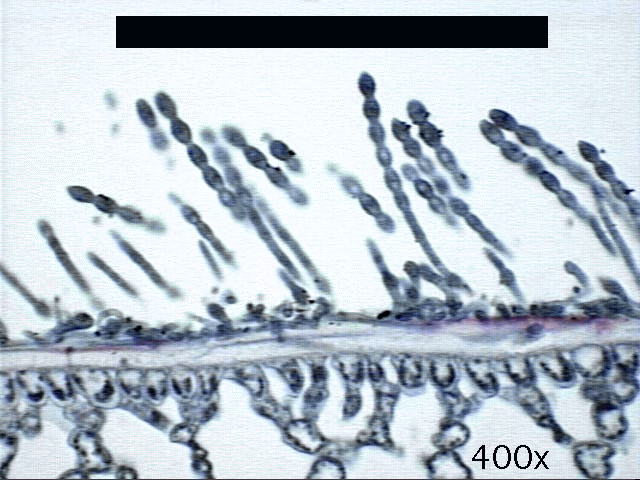
- cleistothecia begin to form on superficial mycelium brown or black specks on leaves.
- Conidia are generally colorless, powdery appearance due to presence
of mycelium near end of summer.
- Claviceps purpurea and ergot of rye
- primarily on rye (sometimes wheat, barley, oats and wild grasses.
- actual damage to crop is low -fungus that causes ergot causes the seeds or grains to be replaced with dark-purple to black sclerotia.
- toxic substances produced in sclerotia including LSD (lysergic acid diethylamide) and other alkaloids.
- symptoms of eating contaminated grain referred to as Ergotism, ergot
poisoning or St. Anthony's Fire. Symptoms include, vomiting, feelings of
intense heat or cold, pain in muscles of the calf, yellow color in face,
lesions on the hand and feet, diarrhea, impairment of mental functions,
hysteria and hallucinations (possibility exists that women accused of
witchcraft and their accusers in Salem, Mass were suffering from ergot
poisoning, accounting for their bizarre behavior), convulsions, gangrene
in limbs, spontaneous abortion in pregnant women, and death. Out breaks
of ergot poisoning is not common in modern time most recent outbreak was
in Ethiopia in the late 1970's
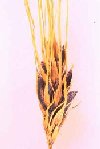
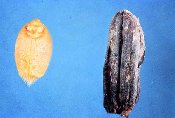
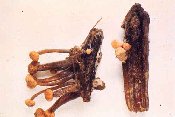
- Some ergot alkaloids have medicinal value. Used medically to stimulate the uterus to contract to initiate child birth, an to hasten the return of the uterus to normal size after childbirth. Treatment of certain peripheral circulatory disorders, and treatment of migraine headaches. Causal agent of ergot of rye is Claviceps purpurea. Fungus overwinters as sclerotia ==> In the spring sclerotia germinate and stroma on a stalk is produced. Ascospores are shot out or extruded in a viscous fluid. Conidia are dispersed by wind and insects. Infects ovary on wild grass plant or cultivated cereal grain
- Fungus causes asexual spores (conidia) to be extruded from flower (honeydew) which is spread by insects. Developing seed replaced with sclerotium.
- For more information visit:
- http://www.botgard.ucla.edu/html/botanytextbooks/economicbotany/Claviceps/
- Linnda R. Caporael Article titled "Ergotism: The Satan Loosed in Salem?" from Science Vol. 192 (2 April 1976) at http://web.utk.edu/~kstclair/221/ergotism.html
- Hymenium partially covers the surface of an open ascocarp ==> "cup
fungus".
- Apothecium (come in many different shapes, sizes, colors, textures etc.).
- Apothecium consists of a hymenium (with parahpyses and asci), subhymenium or hypothecium, different layers of excipulum.
- Asci are operculate (with a lid) or inoperculate (slit or pore present or no opening).
- Ascocarp Development is (a) cleistohymenial (closed throughout formation of ascocarp and ascospore development ==> many of these are hypogeous) or (b) eugymnohymenial (opened from the very beginning of ascocarp development or (iii) paragymnohymenial closes during early development and open at time of ascospore maturity.
- Vegetative structures - sclerotia or stromata possess a hard rind-like
covering, many include host tissue.
- Sclerotium gives rise to mycelium (vegetative growth) or apothecium. Sclerotium is a hardened, resistant structure capable of overwintering or surviving unfavorable conditions. Usually determinant in size and round in shape.
- Stroma are indeterminate in size, irregular in shape and often paddle-like or flattened.
- Discomycetes can be divided into three separate groups
- Inoperculate discomycetes (the Helotiales is the largest order within this group)
- Lecoranalean lichen-forming discomycetes (visit http://www.myra.nu/lavar.html for some great photographs of lichens)
- Operculate forms of Pezizales and their relatives, some of which lack an operculum.
- Helotiales - asci are inoperculate with an apical pore - majority are
saprophytic.
- Monilinia fructicola, the cause of brown rot of peaches. Fungus overwinters as a stroma or mummy from which the apothecium arises in the spring.
- Pezizales (large order and diverse group, operculate asci, generally
saprobic, vary in shape, color and size).
- Fruit bodies or ascocarps are generally common on forest floors in the spring. Group includes Urnula (devil's urn), Sarcoscypha (scarlet cups), Peziza, Morchella, Helvella, Gyromitra. Spores are shot directly into air.
- .
- Tuberaceae - approximates 140 species "truffles" - mycorrhizal and
hypogeous. Hunted using dogs/pigs trained for task. Hypogeous - buried below
ground or leaf-litter. Ascospores are spiny and not dispersed into air.
Ascocarps rot or are dug up by animals and spores released in this manner.
Ascocarps emit a strong odor and are highly prized as food.
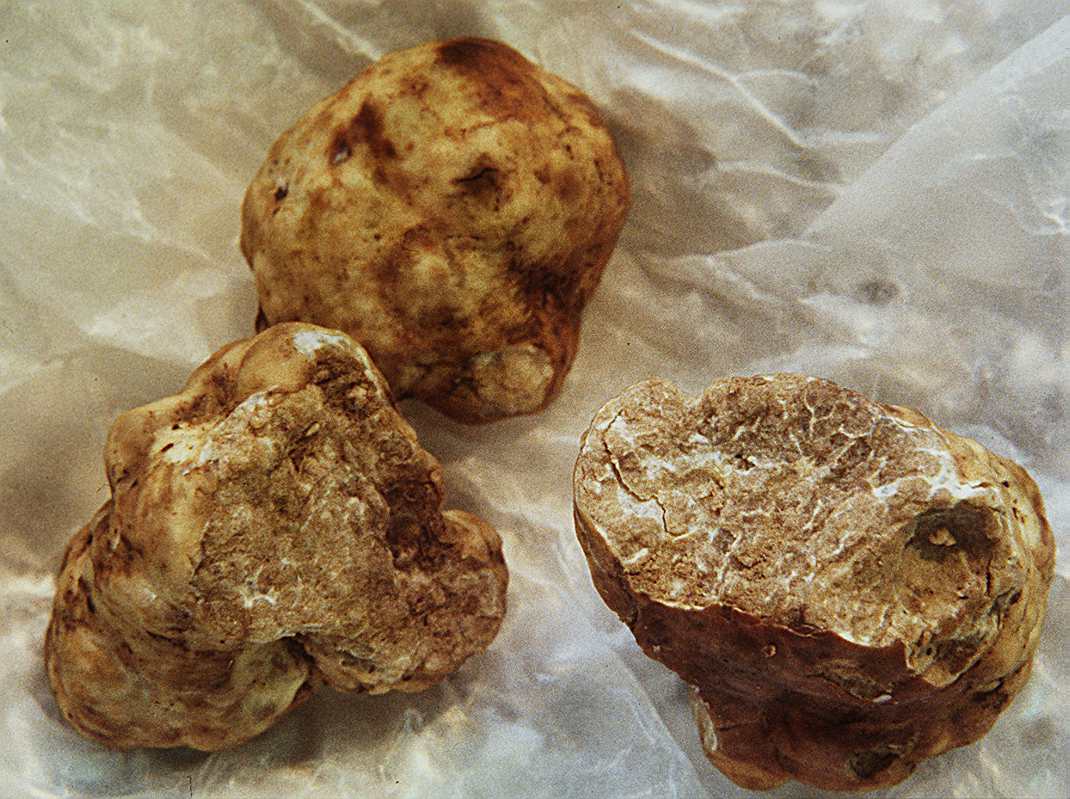
Class Laboulbeniomycetes - "Laboul" -
http://www.bioimages.org.uk/HTML/R150140.HTM
- minute insect parasites -approximately 0.1 to 1.0 mm in size -arthropod are parasitized by these fungi (i.e., roaches, beetles, army ants, mites and other arthropods).
- highly host specific (often found on only one type of host), and position specific (often found on only one part of the host's body)
- Often spread from insect to insect through sexual contact. -Thallus form on outside of body, penetrates the chitinous skeleton and forms haustorium in the integument.
- Fungi have not been cultured.
- Haustorium, foot cell and receptacle (bears sterile hair like appendages, bears male and female reproductive structures), which becomes the perithecium.
- Thalli may be monoeceious (both male and female reproductive structures on the same thallus) -Dioecious
- male and female reproductive structures separate but thalli closely paired.
- Male gametes are spermatia formed by antheridia
- Thaxter - late 1890's described life cycle of labouls. Famous mycoman!
- Stroma in which asci are produced
- Bitunicate ascus (2 walled ascus)
- saprophytes/parasites (examples include Peidraia; perfect stages of Alternaria and Bipolaris)
- Ascostromata form locules not separated by a distinct wall form the stromal tissue pseudothecium (hard to distinguish from a perithecium)
Alcoholic Fermentation by Yeast: Rootbeer, Ginger Ale, Beer, Wine, Industrial Ethanol, and other forms
In addition to the lecture notes that were provided in class, check out the following web sites:
- Root Beer Recipe - this is the one we used in class - http://www.mccormick.com/recipedetail.cfm?id=10482
- http://bugs.bio.usyd.edu.au/Mycology/UsesOf_Fungi/industrialProduction/fermentation.shtml
- http://en.wikipedia.org/wiki/Fermentation
- http://www.botany.hawaii.edu/faculty/wong/BOT135/Lect14.htm
- http://www-micro.msb.le.ac.uk/video/Scerevisiae.html
-
Alcoholism as a Disease
- CDC Facts on Alcohol as a Drug and Alcohol Abuse
- Fetal Alcohol Syndrome
- Alcoholics Anonymous and other treatment options
Drugs and Food Facts about Fungi
- Fungal Drugs:
- Blue cheese, soy sauce, miso, and other products:
- http://bugs.bio.usyd.edu.au/Mycology/UsesOf_Fungi/industrialProduction/foodProcessing.shtml
- http://www.botany.hawaii.edu/faculty/wong/BOT135/Lect16.htm
- http://www.cheese-france.com/cheese/roquefort.htm
- http://en.wikipedia.org/wiki/Roquefort_cheese
- http://en.wikipedia.org/wiki/Blue_cheese
- http://en.wikipedia.org/wiki/Camembert_%28cheese%29
- http://en.wikipedia.org/wiki/Brie_cheese
- http://en.wikipedia.org/wiki/Miso
- http://en.wikipedia.org/wiki/Soy_sauce
- http://en.wikipedia.org/wiki/Quorn
Medical Mycology
Molds can be associated with allergies (to the spores), mycotoxins that contaminate food, disease (depending on the fungus involved infections can be superficial, cutaneous, subcutaneous, mucocutaneous, respiratory, systemic, and/or opportunistic. Infections may be acute (rapid onset) or chronic (prolonged over time).
- Human Mycoses I: http://www.mycolog.com/chapter23.htm
- Human mycoses II: http://www.doctorfungus.org/mycoses/human/human_index.htm
- http://www.doctorfungus.org/
- http://www.cdc.gov/mold/
- http://www.epa.gov/mold/
The following is a compilation of mycotoxins and fungi that pose a health hazard to animals and humans that consume contaminated foodstuffs. However you should be aware that this page lists only some of the major types of toxicoses caused by the secondary metabolites of fungi, and therefore is incomplete.
Fusarium toxins - produced by several species.
-
Zearalenones (produced in molded maize)
- Toxic to swine and causes abnormalities and degeneration of the genital system - also known as "estrogenic syndrome". Male swine show signs of feminization, while female swine are more susceptible to sterility and spontaneous abortion; when offspring are produced, these are often small and weak.
- causes equine leukoencephalomalacia (brain damage and death in horses)
- pulmonary edema (inflammation of lung tissue) in swine
- cancer-causing in humans?
- associated with neural tube defects in human babies
- commonly associated with species of Fusarium found in cereal grains (particularly corn)
- Swine and other animals (especially livestock) suffer symptoms of inactivity, degeneration of the cells of the bone marrow, lymph nodes, and intestines. Leads to diarrhea, hemorrhaging (bleeding) and death.
- One form causes alimentary toxic aleukia (ATA) in humans. This results in abnormalities in blood system. ATA was widespread in rural areas in Siberia (1941-47). Toxins build-up in grain (millet) allowed to over winter in the field. Symptoms include fever, headache, diarrhea, nausea and vomiting. Hemorrhaging in various organs and parts of body worsens as disease progresses and death is not uncommon.
- Fusarium Scab in barley (and wheat) is becoming an increasing problem, especially those grains used to make malt for beer production.
- Another fungus, Stachybotrys charatum is a cellulose decomsoing hyphomycete and can contaminate hay and fodder with trichothecenes used to feed horses. Also it is know to cause hemorrhagic syndrome in the lungs of humans who breath in the spores, especially in the very young by inhibiting normal development of capillaries in the lungs. This is sometimes referred to as TOXIC BLACK MOLD, and is sometimes found on wet wood and paper surfaces in homes.
Claviceps purpurea and ergot of rye
- primarily on rye (sometimes wheat, barley, oats and wild grasses).
- actual damage to crop is low
- fungus that causes ergot causes the seeds or grains to be replaced with dark-purple to black sclerotia.
- toxic substances produced in sclerotia including LSD (d-lysergic acid diethylamide) and other alkaloids.
- symptoms of eating contaminated grain referred to as St. Anthony's Fire, ergotism, or ergot poisoning. Symptoms include, vomiting, feelings of intense heat or cold, pain in muscles of the calf, yellow color in face, lesions on the hand and feet, diarrhea, impairment of mental functions, hysteria and hallucinations (possible that women accused of witchcraft because of bizarre behavior in Salem, Mass were suffering from ergot poisoning), convulsions, gangrene in limbs, spontaneous abortion in pregnant women, and death. Out breaks of ergot poisoning is not common in modern time most recent outbreak was in Ethiopia in the late 1970's
- Some ergot alkaloids have medicinal value. Used medically to stimulate the uterus to contract to initiate child birth, an hasten the return of the uterus to normal size after childbirth. Treatment of certain peripheral circulatory disorders, and treatment of migraine headaches.
- Causal agent of ergot of rye is Claviceps purpurea.
- Fungus over winters as sclerotia ==> In the spring sclerotia germinate and stroma on a stalk is produced. Ascospores are shot out or extruded in a viscous fluid. Conidia are dispersed by wind and insects. Infects ovary on wild grass plant or cultivated cereal grain
- Fungus causes asexual spores (conidia) to be extruded from flower (honeydew) which is spread by insects. Developing seed replaced with sclerotium.
- Control of Ergot:
- depends entirely on cultural and sanitary procedures
- use only clean seed or seed free form ergot should be sown seed can be freed from sclerotia by soaking in a solution of about 18 kg salt per 100 liters of water for 3 hours and floating off sclerotia
- sclerotia do not survive for major than a year and do not germinate if buried in the ground Therefore deep ploughing or crop rotation with a noncereal for a year helps eliminate the pathogen from a field.
- Wild grasses should be mowed or grazed before flowering to prevent sclerotia formation and avoid poisoning of livestock.
- Benomyl (a fungicide) sprays may be helpful if applied before and after flowering
- Fusarium roseum appears to be a hyperparasite of the ergot fungus. Potential biocontrol agent.
- For more information and photographs on ergot check out: http://www1.agric.gov.ab.ca/$department/deptdocs.nsf/all/prm2402 and http://www1.agric.gov.ab.ca/$Department/deptdocs.nsf/all/prm7794
Toxins produced by species of Aspergillus and Penicillium growing on Animal and Human Food Supplies
- Aflatoxins produced by species of Aspergillus, especially A. flavus on peanuts, maize, and other foodstuffs - CLICK HERE!
- Ochratoxins cause degenerate and necrosis of the liver and kidney in domestic animals. These may persist in the meat of animals fed contaminated grain and be transmitted through the food chain to humans.
- Tremorgenic toxins cause marked body tremors and excessive discharge of urine, followed by convulsive seizures that often end in death. Some species of Aspergillus and Penicillium growing on refrigerated foods (e.g., cheese), grains, and cereal products. Sheep, horses and cows seem to be the the domestic animals most commonly affected by tremorgenic toxins. Humans can also suffer this malady.
- Patulin is found to occur naturally in foodstuffs such as fruit or juices made with fruit partly infected with Penicillium, in naturally molded bread and bakery products, and in most commercial apple products. Patulin may constitute a serious heath risk for domesticated animals and humans. Symptoms of poisoning include, edema and bleeding in lungs and brain, damage to kidneys, paralysis of motor nerves, and cancer.
- Yellowed-rice toxins, primarily citreoviridin, citrinin, and luteoskyrin, are all produced by species of Penicillium growing in stored rice, barley, corn, and dried fish. These toxicoses are associated with various diseases, including cardiac beri-beri, nervous and circulatory disorders, and degeneration of the kidneys and liver.
Fescue Toxicosis
- Affects cattle and horses feeding on plants of the perennial grass tall fescue infected systemically with the fungus Acremonium (an endophyte).
- Horses eating tall fescue plants infected with the fungus show only reproductive disorders.
- Cattle feeding on such plants, in addition to reduced calving and lowered milk production, show reduced weight gains, elevated body temperature, and rough hair coat; feet or other body extremities may develop gangrene and drop off "fescue foot".
Bibliography on Fungal Mycotoxins in Food
-
Agrios, G. N. (1997). Plant
Pathology. 4th ed. Academic Press: San Diego.
Leslie, J. F., W. F. O. Marasas, G. S. Shephard, E. W. Sydenham, Stockenstrom, and P. G. Thiell. (1996). Duckling toxicity and the production of fumonisin and moniliformin by isolates in the A and F mating populations of Gibberella fujikuroi (Fusarium moniliforme). Appl. Environ. Microbiol. 62: 1182-1187.
Moore-Landecker, E. (1990) Fundamentals of the Fungi. 3rd. ed. Prentice Hall: Englewood Cliffs.
Rippon, J. W. (1982). Medical Mycology: The Pathogenic Fungi and The Pathogenic Actinomycetes. 2nd ed., Philadelphia.
For Additonal Information on Mycotoxins visit the following links:
- http://www.botany.hawaii.edu/faculty/wong/BOT135/lect11.htm
- http://healthandenergy.com/mycotoxins.htm
FUNGAL PHYSIOLOGY - Brief Overview
-
Monitoring Growth Rate
-
Nondestructive -repeated measurements with time
-
change in radius of a developing colony on agar medium in a petri dish
-
horizontal growth tube (40 cm long with cotton plugs at both ends)
-
changes in light absorption(yeast and other unicellular microorganisms)
-
-
Destructive - requires many flasks to obtain the dry weight gain (biomass)
-
Inoculum is made by suspending spores in a liquid or by chopping up mycelium with a Waring blender.
-
Liquid medium in a plugged flask is inoculated and placed on a shaker in a incubator.
-
Several flasks at are removed at periodic intervals and liquid separated from the solid contents by passing and washing the contents through filter paper.
-
Filter paper is oven-dried and weighed giving the dry weight of the fungus.
-
-
-
Patterns of Growth
-
Log Phase - A period after inoculation before cell division occurs
-
Acceleration Phase - transition between dormancy and active growth
-
For phases #1 and #2
-Spore germination
-enzymatic adaptation to substrate
-healing period -
Exponential Phase - cell division reaches a uniform rate
-
Deceleration Phase - decrease in cell division
-
Stationary Phase - no additional growth =death
-
Decline Phase - decrease in number of viable cells
-
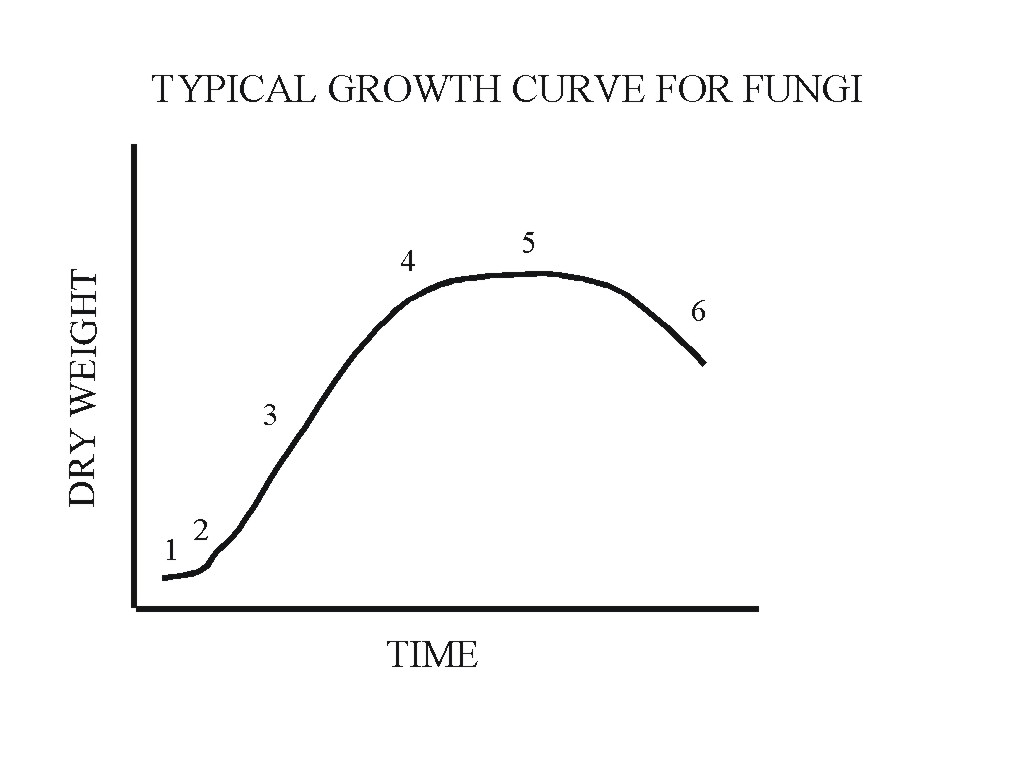
-
Digestion
-
Fungi absorb small molecules (sugars, amino acids) directly from medium.
-
If large molecules present, then fungus must be able to secrete extracellular enzymes to break it down before absorption takes place.
-
If enzyme not available, no food can be utilized.
-
Enzyme induction - enzyme produced in response to the substrate.
-
Catabolite repression - fungus may utilize one substrate over another (glucose over starch).
-
Translocation
-
Translocation of food and nutrients is by bulk flow. Intake of solutes causes the intake of water through osmosis, which moves the food from the source to a sink. A sink is created when food is utilized or converted from glucose to a polysaccharide (e.g. glycogen, cellulose).
-
-
-
Nutritional Requirements
-
natural substrates (dung, wood, grain)
-
natural media --> infusions of material (malt extract, BHI, HI)
-
completely synthetic (consisting of chemicals)
-
semisynthetic medium (natural products + chemicals)
-
-
Essential Macronutrients
-
Essential macronutrients include, carbon, nitrogen, hydrogen, oxygen, sulfur, phosphorus, potassium and magnesium.
-
About 1/2 dry weight of fungus is carbon.
-
structural component
-
provide energy for cell
-
carbon obtained from organic compounds or CO2 from air
-
fungi vary in their ability to utilize monosaccharides, disaccharides, polysaccharide, and organic acids.
-
lignin - a polymer of alcohol derivatives (breakdown produces almost no energy).
-
Nitrogen is necessary for production of amino acids, proteins, and nucleotides.
-
organic nitrogen==> NH4+==> NO3==> NO2
-
Sulfur requirement can be satisfied by adding SO4 (e.g. Mg SO4) to culture medium.. Sulfur is found amino acids (cysteine, cystine, methionine, vitamins (thiamine,& biotin), antibiotics (penicillin), and other compounds.
-
Phosphorous is important for production of ATP in respiration and carbohydrate metabolism and in nucleotides.
-
Magnesium-activation of enzymes (e.g., PGI and PGM).
-
Potassium's role is unknown, but vital. Probably associated with ion pumps in cell membranes.
-
-
Essential Microelements
-
Iron
-
Zinc
-
Copper
-
Manganese
-
Molybdenum
-
either Calcium or Strontium
-
Many of these microelements can be supplied by adding yeast extract to medium.
-
-
Vitamins
-
Some fungi synthesize all the vitamins they require, while others are auxotrophic (vitamins must be supplied).
-
auxotrophic-usually used in context of any substance required by a fungus due to a mutation
-
most common deficiency are for thiamine and biotin.
-
in some cases the presence of a vitamin may not be necessary, but it will enhance growth if present.
-
Histoplasma capsulatum
-
yeast phase (requires thiamine and biotin)
-
filamentous phase (no vitamin required)
-
-
-
Physical Requirements Of Growth
-
Temperature
-
Mesophile -optimum temperature range is usually between 15˚ to 30˚C (min. is 0 to 5˚C, maximum is 35˚ to 40˚C)
-
Psychrophiles-grow at cooler temperatures optimum is 10˚C or below.
-
Thermophilic fungi-growth optimum of 40˚C or above (min. temp. is 20˚C or above, max. may be higher than 50˚C)
-
-
pH
-
pH-hydrogen ion concentration fungi usually grow best at a pH lower than 7.
-
Ammonium Salt- as NH4+ is used up the medium will become more acidic.
-
NaNO3 with time medium will become more alkaline due to release of ammonium.
-
-
-
Moisture
-
maximum growth is achieved at high relative humidity 95% to 100%.
-
growth declines or ceases 80% to 85% RH, although some fungi can grow in RH As low as 65%.
-
osmotic concentrations of solutes in water (salts & sugars) effects growth.
-
some fungi are adapted to solutions high in salt or sugar.
-
-
Light
-
in some fungi low levels of U.V. light exposure for short periods of time induce sporulation.
-
some fungi require light to form normal fruit bodies and to sporulate. For example: Flamulina velutipes or enoke mushrooms (long stipe if growth in dark).
-
strong light generally inhibits growth.
-
-
Aeration- O2 and CO2. All fungi are obligates aerobes, some are facultative anaerobes, none are known to be obligate anaerobes.
-
Fungal diseases that must be overcome to have a traditional Thanksgiving dinner - http://botit.botany.wisc.edu/toms_fungi/thanks.html
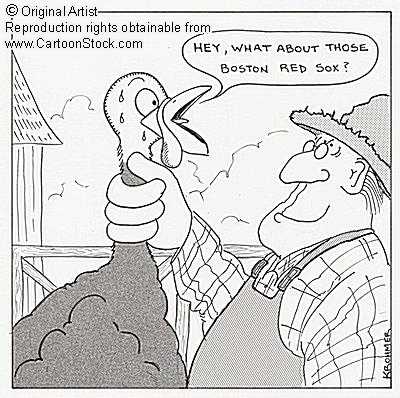

|